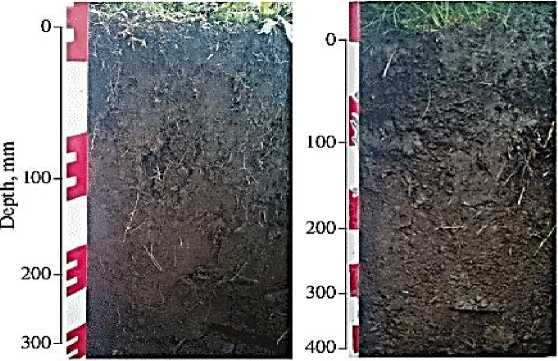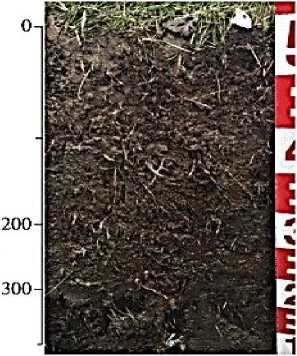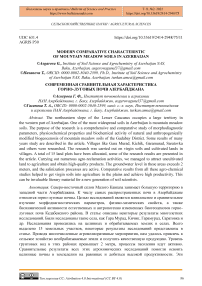Modern comparative characteristic of mountain meadow soils in Azerbaijan
Автор: Asgarova Gyunel, Hasanova Turkan
Журнал: Бюллетень науки и практики @bulletennauki
Рубрика: Сельскохозяйственные науки
Статья в выпуске: 2 т.8, 2022 года.
Бесплатный доступ
The northeastern slope of the Lesser Caucasus occupies a large territory in the western part of Azerbaijan. One of the most widespread soils in Azerbaijan is mountain meadow soils. The purpose of the research is a comprehensive and comparative study of morphodiagnostic parameters, physicochemical properties and biochemical activity of natural and anthropogenically modified biogeocenosis of mountain meadow soils of the Gadabay District. Some results of many years study are described in the article. Villages like Gara Murad, Kichik, Garamurad, Saratovka and others were researched. The research was carried out on virgin soils and cultivated lands in villages. A total of 15 land plots have been allocated, some of the research results are presented in the article. Carrying out numerous agro-reclamation activities, we managed to attract uncultivated land to agriculture and obtain high-quality products. The groundwater level in these areas exceeds 2 meters, and the salinization processes are active. Comparative results from all these agro-chemical studies helped to get virgin soils into agriculture in the plains and achieve high productivity. This can be invaluable literary material for a new generation of soil scientists.
Humification, chemical parameters, classification, salinization
Короткий адрес: https://sciup.org/14122924
IDR: 14122924 | УДК: 631.4 | DOI: 10.33619/2414-2948/75/11
Текст научной статьи Modern comparative characteristic of mountain meadow soils in Azerbaijan
Бюллетень науки и практики / Bulletin of Science and Practice
UDC 631.4
Azerbaijan possesses 9 of 11 world climatic zones, which are characterized by the development of unique and endemic soil types [1, 2].
The meadow soil type was first studied in 1908 in Central Asia. The formation of mountain meadow soils is mainly formed on loess rocks [9, 10].
The latitude and longitude of the study area is in this range E 45o 0'-47o 08' N 41o17'- 40o19'. Average annual humidity 75%, annual precipitation 600–900 mm. The average annual wind speed is 2.2 m/s [8].
The activity of the studied enzymes is subject to seasonal changes. in the spring and autumn seasons with more favorable hydrothermal conditions, the activity of enzymes was higher, while in summer a significant depression occurs in the life of the soil biota, which contributes to the weakening of their biochemical capacity [3, 4].
For a long time, the use of the soils of the Gadabay District for various economic purposes was accompanied by a certain anthropogenic load on the surrounding cenosis [6].
A comparative study of possible changes in some physicochemical and biological properties in natural cenosis and agrocenosis is particular importance and relevance. There is no forest cover in the Cehrichay basin. It is a stormy and abounding river. This river has 7 tributaries, the selfregulation coefficient is 0.67. The volume of annual imports is 28,000 tons [7].
Methods
At each selected site, soil sections were laid down to the depth of the parent rock. In quiet sections, samples were taken for soil analysis (Figure1, 2).
3,38 2,98
1,9
0,36 0,22 0,18
Humus
Dry residue
0,286 0,198 0,154
Salts
■ 0-28 sm ■ 28-65 sm ■ 65-102 sm
Figure 1. The percent of Humus, dry residue and number of salts in different depths
Totally 15 land plots were laid. Some of the physical and chemical parameters characteristics are shown in the following tables (Table 1, 2).
In several villages of the Gadabay District, soil samples were taken from soil crops and their physical-chemical properties were studied. The studies were carried out in different seasons of the year both in natural and cultivated cenosis. At the same time, the quality of river water passing through the territory of the Gadabay District and used as irrigation water was studied [5, 7].


Figure 2. The mountain meadow soil classification in different depths
SOME OF CHEMICAL CHARACTERISTICS OF CROPS NUMBERING 10 AND 11
Table 1
|
Crop/depth |
Total phosphorus % |
Total Na % |
Humus % |
Nitrogen % |
pH % |
|
Crop 10 |
|||||
|
0-16 cm |
0.26 |
2.35 |
3.27 |
0.39 |
7.8 |
|
16-37 cm |
0.22 |
2.12 |
2.32 |
0.23 |
7.9 |
|
37-58 cm |
0.20 |
2.97 |
1.81 |
0.37 |
7.5 |
|
58-77 cm |
0.13 |
2.13 |
1.17 |
0.21 |
7.4 |
|
77-118 cm |
0.09 |
2.18 |
0.68 |
0.32 |
7.5 |
|
118-152 cm |
0.11 |
3.08 |
0.25 |
0.20 |
7.3 |
|
Crop 11 |
|||||
|
0-32 cm |
0.23 |
2.27 |
4.91 |
0.34 |
7.9 |
|
32-58 cm |
0.20 |
2.13 |
3.27 |
0.32 |
7.6 |
|
58-92 cm |
0.18 |
2.10 |
1.20 |
0.27 |
7.3 |
Table 2
SOME OF PHYSICAL AND CHEMICAL CHARACTERISTICS OF CROPS NUMBERING 12 AND 15
|
Crop/depth |
Granulometric % 0-100 cm |
Dry residue % |
Number of salts % |
Ca % |
Mg % |
SO 4 % |
Cl % |
HCO 3 % |
|
|
Crop 12 |
< 0,001 mm |
˂0.01 mm |
|||||||
|
0-17 |
10.80 |
29.56 |
0.120 |
0.178 |
0.010 |
0.005 |
1.895 |
0.32 |
0.36 |
|
17-65 |
15.67 |
30.78 |
0.180 |
0.178 |
0.008 |
0.002 |
2.394 |
0.32 |
0.32 |
|
65-94 |
17.60 |
48.05 |
1.130 |
0.064 |
0.012 |
0.002 |
0.167 |
0.4 |
0.4 |
|
94-130 |
19.26 |
51.07 |
0.140 |
0.226 |
0.021 |
0.004 |
1.707 |
0.4 |
1.04 |
|
Crop 15 |
˂0,001mm |
˂0.01mm |
|||||||
|
0-28 |
11.70 |
19.23 |
0.360 |
0.286 |
0.027 |
0.004 |
2.394 |
0.36 |
1.2 |
|
28-65 |
12.67 |
16.65 |
0.220 |
0.198 |
0.021 |
0.004 |
1.377 |
0.32 |
1.04 |
|
65-102 |
15.80 |
19.90 |
0.180 |
0.154 |
0.011 |
0.002 |
1.541 |
0.44 |
0.36 |
Results
Carbonization is observed along the profile, starting from the surface of 0–25 cm. The rest of the salts and compounds were washed off the profile. Gray soils are prone to salinization. The soils of these and other territories differ depending on the conditions of soil formation and the natural cenosis. The results of the analysis of seasonal studies of the content of nutrients in dependent particles of irrigation water show that a significant amount of nutrients is introduced to the fields by dependent water particles. This has a positive effect on the fertility of irrigated lands and an increase in their productivity.
Saratovka, 1340 m above sea level 250 m east of the gorge southwest gentle undulating slope, rocky pastures. Ca2+ and Mg2+ in mountain meadow soils gradually increases from the upper horizons 0.010% — 0.002%, to the lower 0.027% — 0.004%. The Na+ content also increases from the upper horizons of 2.27% to the lower ones, amounting to 3.08%. On the agrocenosis of forage plants, the content of Ca2+ and Mg2+ cations along the profile are much higher than in virgin soils of the natural cenosis. The total amount of Na+ and K+ increases both in the upper horizons and in the lower horizons. In mountain meadow soils of natural and cultivated cenoses, the pH changes between 7.3–7.8. The following chart shows the percent of humus, dry residue and total salts in mountain meadow soils of Gadabay District (Figure 1).
In river sediments, the content of absorbed bases does not change in contrast. The content of Mg2+ and Ca2+ cations is 4.3 mg/equiv. and 9.6 mg/ equiv. It was revealed that the activity of catalase in natural cenoses of the studied soils varies between 2.03-2.80 ml O 2 /g. soil, invertase 3.80-6.90 mg. gluc./g. soil and urease 2.88 mg.NH 3 /g. soil. A close correlation was found between soil moisture and enzymes (catalase, invertase) respectively, for cenoses 0.59–0.84; 0.66–0.89; and 0.74–0.94; 0.67–0.98 and 0.7–0.80.
Список литературы Modern comparative characteristic of mountain meadow soils in Azerbaijan
- Аскерова Г. Ф. Внедрение биологически активных веществ и биогумуса для восстановления плодородия орошаемых лугово-сероземных почв // Экологический вестник Северного Кавказа. 2019. Т. 15. №3. С. 22-25.
- Гасанова Т. А., Маммадова Г. И., Асгерова Г. Ф. Фитомасса серо-бурых почв, формирующаяся в аридной экосистеме Азербайджана // Бюллетень науки и практики. 2021. Т. 7. №9. С. 110-115. DOI: 10.33619/2414-2948/70/11
- Hasanova T. A.Complexes (Ecogroups) of the invertebrates, phytomass and dinamics of microbiological population and their importance at grey-brown soils diagnostics in Azerbaijan // Universal Journal of Agricultural Research. 2015. V. 3. №4-2015. P. 130-134. DOI: 10.13189/ujar.2021.090301
- Hasanova T. A. General characteristic of microbiotes in soils of the Great Caucasus // Science and education yesterday today tomorrow. The X international scientific symposium dedicated to the 880th anniversary of Nizami Ganjavi. Stockholm. 2021. P. 344-348.
- Hasanova T. A., Hasanov A. B. Soil-melioration peculiarities in basin of Kish River // Annals of Agrarian Sciences. 2021. V. 19. №2. P. 126-135.
- Hasanova T. A., Mammadova G. I., Bunyatova L. N., Gahramanova A. Y. Importance of Biodiagnostics and Irrigation Gray-Brown Soils // Universal Journal of Agricultural Research. 2021. V. 9. №3. P. 63-69. DOI: 10.13189/ujar.2021.090301
- Hasanova T. A. Application ICT to Research the Influence of Flooding of the Kish River on Agroecological Indicators of Irrigation Water and Soils of Natural Cenoses // Southern Caucasus Scientific. 2021. V. 59. P. 68-74.
- Гасанова Т. А. Основы удобрений на серо-луговых почвах Кедабекского района Азербайджана // Ломоносов 2021: Материалы XXVIII Международного молодежного научного форума. 2021.
- Bull J. W. (ed.). Soil-Structure interaction: numerical analysis and modelling. CRC Press, 2002.
- Tan K. H. Soil sampling, preparation, and analysis. CRC press, 1995.


